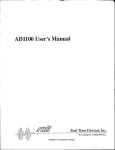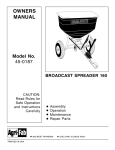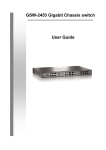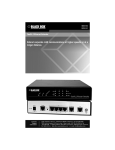Download User Manual
Transcript
16/24 Ports Managed PoE Ethernet Switch 16/24FE POE+2GE User Manual Preface The user manual mainly introduces the product shape, product positioning, hardware installation, Web management and other related information. I l l u st r a t i o n (1)Format of Graphics Interface Format < > [ ] Description “<>”means button name, such as “click <Confirm> button”. “[ ]”means window name, menu name and data table, such as“pop out [New user] window”. “/”is used to seperate Multi-level menu. Such as [file/new/folder] multi-level / menu [file] menu [new] sub-menu [folder] menu option. (2)Va r i o u s S igns Caution Instruction Improper operation may damage the device or cause data loss. Supplemental instruction for operation contents. Content 1 Product Introduction 1.1 1.2 1.3 1.4 Overview Product Feature Board Diagram Specification 2 Installation 2.1 Shipping List 2.2 Installation Precautions 2.2.1 Safety Precautions 2.2.2 Installation Requirements 2.2.3 The Requirements of Electromagnetic Environment 1 1 1 1 3 4 4 4 4 5 5 6 6 2.3 Installation Way 2.3.1 Rack Installation 2.3.2 Workbench Installation 2.3.3 Wall-hung Installation 7 7 2.4 Cable Connection 2.4.1 Device Connection 2.4.2 Configuration Cable Connection 2.4.3 Power Cable Connection 9 9 9 9 3 Function Configuration Guide 10 3.1 Computer Requirements 10 3.2 Set up Network Connection 3.2.1 Set Static IP for the Management Computer 3.2.2 Confirm the Network Connection by Ping Command 3.2.3 Cancel the Proxy Server 10 3.3 Web Page Configuration Guide 3.3.1 Start and Login 3.3.2 Change Language 3.3.3 Common Buttons Introduction 3.3.4 The Default Configuration 3.3.5 Web Users Timeout 3.3.6 Backup System Configuration Information 3.3.7 Restoring the Configuration Information 3.3.8 Quit 10 12 12 13 13 14 15 15 17 17 17 17 4 Web Management 4.1 System Status 4.2 Port Configuration 4.3 VLAN Setting 4.3.1 VLAN Configuration 4.3.2 VLAN forwarding 4.4 Trunk Management 4.4.1 Trunk 4.4.2 RSTP 4.5 Port Security 4.5.1 Static Address Latch 4.6 Web Management 4.6.1 SNMP Setting 4.6.2 Email Alarm 4.7 Network Statistics 4.7.1 Network Statistics 4.7.2 MAC Address 4.8 System Management 4.8.1 IP Address 4.8.2 User Management 4.8.3 Log Information 4.8.4 File Management 4.9 PoE Management 17 17 18 20 20 22 23 23 24 28 28 29 29 30 31 31 32 33 33 34 35 36 37 1 Product Introduction Back panel 1.1 Overview This item is a 16/24-port managed PoE Ethernet switch, which provides 16/24*100Mbps downlink PoE Ethernet ports, supports IEEE802.3 af/at and 2*1000Mpbs uplink Ethernet ports. It supports Layer 2 network management and PoE management based on web and provides high-speed data forwarding. It is widely used in security surveillance, network engineering projects and so on. AC Power Input Port 1.2 Product Feature Ground 16 Ports 100M Managed PoE Switch Board Diagram 16/24 ports managed PoE Ethernet switch provides 16/24 * 10/100Mbps downlink PoE Ethernet ports and 2 * 10/100/1000Mbps uplink Ethernet Front panel ports; Recover IP & password port Provide web-based layer 2 network management and PoE management with simple operation process; Support high-speed data forwarding, perfectly designed for large flow of Uplink Gigabit Ethernet Port video data forwarding in security surveillance; Support one-key recovery of IP address & user password; Excellent circuit isolation protection, lightning protection up to 2 KV ; Quick installation, easy operation and convenient for wall/ desk/ rack installation. 1.3 Board Diagram 100Mbps PoE Ethernet Port Indicate Power Working Status 24 Ports Managed PoE Ethernet Switch Board Diagram Indicate downlink 10/100Mbps Working Status Front panel Recover IP address and password 100M PoE Ethernet port Uplink Gigabit RJ45 Port Indicate power I ndicate downlink 10/100Mbps status PoE status 1 Back panel AC Power Input Port Ground 2 1.4 Specification 2 Installation Item Products Power Description Products Mains on load Anti-counterfeiting label is attached to switch's cover. Product damage Voltage Range AC 100~240V caused by unauthorized disassembly is not covered under warranty. Ethernet Port 250W 370W 1~16/24 Ports: 10/100Mbps Ethernet port, adaptive control UPLINK Ethernet port: 10/100/1000Mbps Ethernet port Transmission Distance 1~16/24 ports: Recommended 120m Max.150m; Uplink 1000Mbps Ethernet port: Max.150m PoE Protocol IEEE802.3af,IEEE802.3at PoE Power Supply End-span PoE Power Consumption Network Switch Network Standard EachPort≤30W, Total ≤250W Each Port≤30W, Total≤370W IEEE802.3 10BASE-T, IEEE802.3u 100BASETX, IEEE802.3ab 1000BASE-T, IEEE802.3z Switch Capacity 16G Management Management Management L2 ESD Level 3, Per: IEC61000 - 4 - 2 Protection Communication Port Lighting Protection Level 3, Per:IEC61000-4-5 Working Temperature 0℃ ~55℃ Environment Storage Temperature al Humidity (non-condensing) Mechanical Caution 16 Ports PoE Ethernet Switch Power Supply Consumption Network Connector 24 Ports PoE Ethernet Switch P lease check the following items before installation, if any missing, please contact your local dealer. Quantity Item Name Unit 1 Device 1 Set 2 AC Power Line 1 Piece 3 Accessories 1 Set 4 User manual 1 Piece 2.2 Installation Precautions To avoid device damage or personal injury by improper use, please observe the following precautions. 2.2.1 Safety Precautions Instruction - 40℃~85℃ This is level A product, which may cause radio interference in living 0~95 % environment. Users may need to take corresponding and effective Dimension (L×W×H) 442mm×124mm×44.5mm Material Sheet metal measures to solve the problem. Black Color Weight 2.1 Shipping List 2.79kg 2.69kg Products are subject to change without prior notice. 3 4 Pull out the power plug before cleaning the switch. Do not use wet cloth nor liquid to wipe or wash the switch; Do not leave the switch close to water or wet place so as to prevent water or dampness 2.3 Installation Way There are 3 installation ways: rack, workbench and wall-hung installation. from entering into the switch; Make sure the switch work in a clean environment. Excessive dust may cause electrostatic adsorption, which will affect the equipment life and cause communication Caution failure; The switch will work normally under the correct voltage. Please ensure the voltage indicated on the switch corresponds to the power voltage; To avoid the danger of electric shock, please do not open the switch case. Do not open the switch case even if the switch is powered off; Please pull out the power line before installing or moving the switch. Grounding and anti-lightening can greatly increase the protection level of the switch. please connect the earth terminal to the earth by using at least wire 20. The accessories (including but not limited to power lines, etc.), which can be used for the switch only, is prohibited for other applications. 2.2.2 Installation Requirements The device should work in indoor environment to avoid thunder stroke. It is important to Instruction The diagram is for reference only, the products are subject to actual product. obey the following requirements no matter you install it in the cabinet or on the workbench directly: 2.3.1 Rack Installation Enough space (larger than 10cm) for air outlet so as to facilitate the heating dissipation; Good ventilation system for cabinets and workbench; Cabinet and workbench is sturdy enough to support the switch and it's accessories's weight; Cabinet and workbench have good grounding. Installation process: (1) Check rack grounding and stability; (2) Use screws to fit hangers at the device board side; 2.2.3 The Requirements of Electromagnetic Environment When it is working, the switch may be affected by external interference outside the system through the ways of radiation and conduction. Please pay attention to the followings: AC power supply is TN system, so it is necessary to use single phase power socket (PE) which can protect ground wire so that the filter circuit can effectively filter out the power grid disturbances; The switch should work far away from high-power radio transmitters, radar Figure 2-1 Install hangers diagram transmitters, high-frequency devices; Use electromagnetic shielding if necessary, such as shielded cable; (3) Put the device on the rack’s bracket and move the rack along the slot to Interface cables should be arranged indoor rather than outdoor to prevent over- proper position ; voltage and over-current caused from damaging to the signal port. (4) Use screws to fit the installation hanger at rack’s fixed slot, make sure the device is installed at rack’s bracket steadily. 5 6 Figure 2-3 Hangers installation diagram (2) Drill holes on the strong position of wall and then drive the rubber plug into the hole; (3) Drive these screws into the hole for the rack and fix the product by aiming at Figure 2-2 Install switch to the rack the rubber plug . Instruction This product’s installation hangers are just to fix the switch rather than support it. Use brackets under the device (fixed to the rack) to support switch when install the switch to the rack. Figure 2-4 Fix the switch on wall 2.3.2 Workbench Installation You can put this product on clean, stable, grounded workbench. The installation procedure is below: (1)Carefully put the device upside down, clean the grooves on the chassis backplane with soft cloth to make sure there is no oil or dust in it; (2)Remove the stickers on the foot pad, paste the foot pad in backplane groove; (3)Carefully put the device upright on the workbench. 2.3.3 Wall-hung Installation You also can put the product on clean, steady vertical wall. Installation procedure is below: (1) Use the screws to fix the hangers; 7 8 2.4 Cable Connection 3 Function Configuration Guide 2.4.1 Device Connection 3.1 Computer Requirements Use cross network cable or cross-over cable to connect PC or other device with switch's Ethernet port; 2.4.2 Configuration Cable Connection Use a network cable to connect all Ethernet ports ( Notice: The VLAN ID of this Ethernet port must be 1) with management PC, and use management PC to configure the PoE switch. Make sure the management PC has already been installed with Ethernet adapter; Use network cable connect Ethernet ports with network card of PC. 3.2 Set Up Network Connection Instruction (1) You need to set the IP of the PC and the switch in the same network segment. The default IP address of the switch is 192.168.1.200, gate is 255.255.255.0. (2) The port to connect management PC for Web setting must be management VLAN. By default, management VLAN is VLAN 1,and each port of the switch is VLAN1. (3) If you need to connect the remote network, please make sure the management PC and the router can make this. (4) This product can't assign the IP address for the management PC, you need to set the management static IP by yourself . Figure 2-5 Connect configuration cable 2.4.3 Power Line Connection (1 ) Connect one side of switch’s power line with the switch's AC power port, and connect the another side with external AC power socket; (2)Turn on the power ,c heck if switch's AC power indicate light is on, on 3.2.1 Set Static IP for the Management Computer Operation steps (take Windows XP as sample): (1) Click <start> to enter the [start] menu, select “control panel”. Double click “network connection” icon, means power connected correctly; double click the “local connection” (3)Use the power line snap to jammed the AC Power line. icon, pop out “local connection status” window. Figure 2-6 Connect power line 9 10 (2) Click <property> button, enter "local connection property" window. 3.2.2 Confirm the Network Connection by Ping Command Operation Steps below: (1) Click <Start> button to enter [Start] menu, select [Run], pop out the dialog. (2) Input "ping 192.168.1.200", click <confirm> button. If there is equipment response show in the pop out dialog, that means network connection succeed, otherwise please check if the network connection is correct. (3)Select "Internet protocol (TCP/IP), click <property> button, enter”Internet protocol (TCP/IP) property” window. 3.2.3 Cancel the Proxy Server Select “ use the IP address below” If this management PC use proxy server to visit the internet, then you must prohibit the button, input IP address ( use arbitrary proxy service, following is the operation: value between 192.168.1.1~ 192.168.1.254, besides 192.168.1.200) and the subnet mask(255.255.255.0). (1) In browser, select [ tool/Internet option] enter [Internet option] window. Click "OK" to finish the configuration. Instruction DNS server address can be empty or be filled in with the real server address. 11 12 (2) Select “connection” tabs in [Internet option] window, and click [LAN Setting] button. Caution Please follow the steps to check if the switch is installed correctly: (1) Whether the physical connection of the equipment is correct? Use network line to connect the product’s network ports (except Console port) with management computer network card, and ensure the link indicator light of the network port is on. (2) Whether the computer TCP/IP agreement setting is correct? Your computer's IP address must be 192.168.1.x (x range is 1 ~ 254 and x (3) Make sure the “Use proxy server for LAN”option is not selected. If selected, please can not be 200, otherwise it will conflict with the product IP address cancel it and click <yes> button. 192.168.1.200 ), subnet mask: 255.255.255.0. (3) Whether the computer's port VLAN ID is 1? The menu bar has the following options: [System Status], [Port Configuration], By default, the management VLAN is VLAN 1, so as each port of switch. [VLAN Settings], [QoS management], [link management], [Port Security], [network management], [Network Statistics], [System management], [Exit] and After inputting the correct password, click <Login in>, the browser will display drop-down menu bar of the "language switching function". Click a option to the product Web management page as the picture below: make corresponding setting. The following will explain the function of each option. 3.3 Web Page Configuration Guide The browser version recommend:IE7 and later, Firefox browser, Chrome, 360 browser (IE7 and later). 3.3.1 Start and Login This product web default IP address: 192.168.1.200, subnet mask: 255.255.255.0, administrator account: admin, password: admin. After installing the equipment Web management page diagram correctly and setting up the computer, open the browser, input the switch 3.3.2 Change Language default address in the browser address bar: http://192.168.1.200 , then press the Enter key, the user login page will show in front of you as As shown below, in the upper right corner of the Web page, click on the dropdown menu bar, select [Chinese] or [English], to complete Web language switching. follows: 13 14 Table 3-2 Default Configuration Options Default Configuration Web English language switching page diagram Username / password admin/admin IP Address Subnet Mask:255.255.255.0 MAC address table aging time 300 Seconds Ports Status Enable Ports Speed Rate Auto-negotiation Port duplex mode Auto-negotiation Flow Control Open Trunking Port does not converge Port Speed Limitation No limitation for Speed Port Link Type Access Management VLAN VLAN 1 VLAN Function Mode Port-based VLAN 3.3.3 Common Buttons Introduction IP Address:192.168.1.200 System Table 3-1 Web commonly used function buttons introduction Button Help Function Open the online help page of Settings page to display the help information for current page. Confirm Submit the input i nformation and confirm the information the current system provided. Cancel Cancel the current configuration input Return Return to the previous page New page Create a new project of the current page Select all Port Select all the ports of the current page VLAN Refresh Refresh the current configuration page Delete all To delete all configuration items the section selected 3.3.4 The Default Configuration The following table lists some important default configuration of the switch, all features will be described in details in following chapters. The default MAC Binding No Binding RSTP RSTP Function Close Network Management SNMP Close configuration is for most cases. Please reconfigure if the default configuration does not match the actual requirements. 15 16 Specification 3.3.5 Web User Timeout When you have left the Web setting page for a while, the system will log out and return to the Web dialog box due to system time-out. Please log in again if you want to proceed the operation. Description Display different time zones around the world. For example, Word Time Zone select Automatically Adjust Daylight Saving Time in daylight saving time zone. Time Configuration You can select local time or use NTP NTP is used when all the equipment clocks in the network Instruction have to be kept the same so as to ensure the accuracy of the NTP Sserver Web page login timeout setting defaults to 5 minutes. System Time PC Time 3.3.6 Backup System Configuration Information Click <Backup> button to select the configuration file backup path, click <OK> button to save the current configuration to the computer. The configuration can be restored through the document [* .cfg] . Device Name clocks. Enter the correct NTP server’s IP address to start the setup. The current time of the device, if you did not get the NTP updated time, then it will start to count from 0:00,1970. Computer current time Network identification device used to facilitate the integrated management tools such as SNMP to judge different equipment. Contacts Equipment maintenance personnel’s Contact Information Contact Address Equipment maintenance personnel’s Contact Information Hardware address of the device is unique since it is 3.3.7 Restoring the Configuration Information MAC Address Click <Browse> button, select previous backup file[* .cfg], click <Recover> button. The configuration information stored in the backup file will be restored to the device, the configuration takes effect after the device restarts automatically. 3.3.8 Quit Click the [Exit] menu item in navigation bar, return to the system status screen, the login box will be popping out automatically till the next click on the page. determined by the length of 48 bits (6 bytes), Hexadecimal digits. Pay attention to software release limit for the hardware version. There are more functions in the updated software Hardware, Software Version version, some of which have new requirements about Running Time hardware version. The time period since equipment has been running. when the device is restarted, the time needed to be recalculated. 4.2 Port Configuration 16 port switch panel silkscreen port and Web port correspondence table 16 Ports Managed PoE Ethernet Switch 4 Web Management 4.1 System Status The meaning of specification in the page shown as below. Table 4-1 Specifications description Web Port Silkscreen Port(up) Web port Silkscreen 2 2 10 10 3 3 11 11 4 4 12 12 5 5 13 13 6 6 14 14 7 7 15 15 8 8 16 16 17 1 18 2 24 port switch panel silkscreen port and Web port correspondence table 24 Ports Managed Ethernet Switch/ PoE Ethernet Switch Web Port 1 2 3 4 5 6 7 8 9 10 11 12 1 2 3 4 5 6 7 8 9 10 11 12 13 14 15 16 17 18 19 20 21 22 23 24 25 1 26 Silkscreen Port (down) 13 14 15 16 17 18 19 20 21 22 23 24 2 Web Port Silkscreen Port (up) 17 1 1 9 9 18 On the [Port security / Port Settings] page, you can observe all the current Configuration direction: switch port status information and can set [Port Enabled], [port rate], [Flow To set the port 1-10 to 100Mbps half duplex mode, and disable the flow control function, please follow these steps: Control], [Port range], shown as figure 4-1. Enter 1-10 (or click on the box in front of the port) in the range of ports; Click the port speed drop-down menu to select 100Mbps; Click dual- duplex mode on the drop-down menu to select half-duplex; Click flow control the drop-down menu to select the Disable ; Click Edit; Operation ends. Instruction 1-24 port for downlink RJ45 ports, at a rate of 10 / 100Mbps adaptive, which can be manually set to 10M or 100M mode. Figure 4-1 Port configuration diagram 25-26 port for uplink optical ports, at fixed rate of 1000Mbps. The specification meaning in this page shown as below 4.3 VLAN Setting Tabel 4-2 Specification Switch supports two VLAN modes: (1) Port-based VLAN mode: define VLAN members according to device port. Description Specification Port Enable / Disable Display the data forwarding of the port. If a port is off, you can not forward the data. Enabled by default. Display the port configuration’s speed rate, including 10M, 100M, 1000M, auto-negotiation. It defaults to Auto- Port Speed Rate negotiation, which means the port can automatically and Duplex Mode After you specify the port to a VLAN, specified VLAN Packets can be forwarded by the port. (2) 802.1Q VLAN mode: Defined by IEEE802.1Q protocol. Process the packets by identifying the packets tags. 4.3.1 VLAN Configuration directly connected the device on the other side to negotiate On [VLAN / Port VLAN] page, you can observe the VLAN settings of all the the port speed. It defaults to Auto-negotiation mode. Display the port configuration’s duplex status, including full- current port switch and can set several functions such as [Port range], [Link type], [Default VLAN ID], [VLAN forwarding list], [vlan-untagged mark list] , as duplex mode, half-duplex mode, and auto-negotiation mode. shown in figure 4-2. It defaults to auto-negotiation mode. Choose whether to enable the function of flow control When two switches have enabled the function of flow control, if one of the two switches has congestion, it will send message to the other switch to notify it to temporarily Flow Control stop sending messages or slow down the sending speed. After receiving the message, the other switch will stop sending or slow down the sending speed of messages so as to avoid packet loss and ensure normal operation of network services. By default, the flow control function of the port is enabled. Figure 4-2 Diagram of VLAN setting page The meaning of the parameters on this page are as shown below. Table 4-3 Parameter description as the following table: 19 20 Parameter Description Access :port, which is normally used for connecting Port Type Received message without Tag devices, only belongs to one VLAN. By default, all ports Link Type are Access ports. The default VLAN ID Access network devices. port for the packet with the corresponding VLAN Tag. Default VLAN ID Enter the ID number which is needed to be divided. (generally 1-4094) message message with processing and default VLAN ID is the same, receive the packet. When the VLAN ID Delete message Tag before transferring it. and default VLAN ID is different, When the VLAN ID VLAN Forwarding VLAN packets can be transferred, other will be discarded. list VLAN untagged mark list Received When the VLAN ID Trunk : port belongs to multiple VLAN and can receive and send multiple VLAN packets. It is normally used to connect Transferred Received message processing Compare port default When VLAN ID VLAN ID to check allowed to pass whether it is allowed by through in the VLAN Port forwarded packets can be set in VLAN. Untagged the VLAN ID, if yes, the without a tag , but other can not. Trunk ID, then receive the default message with packet. If the VLAN port VLAN ID ID is not allowed to corresponding VLAN pass through the Configuration Guide: Tag; No, discard the VLAN ID, the packet Such as if port 1-10 has connected to a switch respectively, it is necessary to packet. is discarded. divided port 1-10 into VLAN 20. and default VLAN ID is the same, remove the tag and send the message. When the VLAN ID and default VLAN ID is different, and is allowed to pass through the port, maintain the original tag and send the message. Enter 1-10 within the port range(or click on the box in front of the ports); Choose Trunk on the menu(Switches connection is generally used with Trunk Caution mode); Enter 20 to default VLAN ID; Enter 1-10 to VLAN forwarding; Enter on VLAN flag list based on actual relationship (the receiving and sending of packets for port is shown in Table 4-4); The default port VLAN and allowed VLAN must be existed VLAN. 4.3.2 VLAN Forwarding Press Set to save the setting; On[VLAN / VLAN forwarding] "page, you can observe the current port Operation ends. VLAN forwarding information, shown in figure 4-3. Instruction VLAN ID range is 1-4094, VLAN flag list must be in the range of VLAN forwarding list. Table 4-4 Port processing of transferring and receiving message. 21 Figure 4-3 Diagram of VLAN forwarding 22 The page parameter description as the table shown. Configuration Guide: Table 4-5 parameter description Such as connect the switch A’s 1-2 ports with switch Description Parameter VLAN ID VLAN Name Select 1 and 2 ports; VLAN ID needed to be changed Click Save; Change the VLAN name that need configuration Switch B and Switch A in consistent procedure; Configuration Instruction: B’s 1-2 ports Enable a convergence group in switch A; End. Such as revise VLAN20 name from sales department to financial department. Caution Enter 10 to VLAN ID (or click on the box in front of the VID10); Enter financial department to VLAN Name; In the same convergence group, the port speed, duplex mode, and Press Revise to save the setting; basic configuration must be consistent. End. STP consistent configuration, including STP ports on / off, STP 4.4 Trunk Management 4.4.1 Trunk priority, STP cost, whether to open loop guard and root guard, or edge ports. QoS configuration is consistent. TRUNK means port convergence, configure the software settings and VLAN connect two or more physical ports to become a logical path to increase port of VLAN ID. Link type on the ports is consistent. consistent configuration, including permitted VLAN, the default the bandwidth between switches and network nodes. The bandwidth merge of several ports provides an exclusive high bandwidth several times than an independent port. On [LACP / TRUNK] page, you can observe the current port link convergence information, shown in Figure 4-4. 4.4.2 RSTP 4.4.2.1 RSTP Uses STP (Spanning Tree Protocol) is established in accordance with IEEE 802.1D standard. It is developed for the elimination of the data link layer loops in the LAN protocol. Devices running this protocol exchange packets with each other to find loops in the network, and choose to block some certain ports. This will eventually make the loop network structure into a loop-free tree pruning network structure. Thus it prevents packet proliferation and infinite from cycling in loop network, avoiding declined processing capacity and repeated receiving of same messages. Figure 4-4 Trunk link diagram Instruction STP contains two meanings, narrow meaning of STP is defined in IEEE 802.1D, board meaning of STP includs IEEE 802.1D defined STP and Each convergence group supports up to eight ports.Port with the various enhanced spanning tree protocol produced on the basis of STP following cases can not be added to an convergence group: (such as RSTP protocol). (1) Port with 802.1x function; (2) The mirror port; (3) Port with MAC address binding. 23 24 4.4.2.2 STP Basic Concept 4.4.2.3 (1) The root bridge RSTP Introduction RSTP (Rapid Spanning Tree Protocol) is an optimized version of STP. It Network structure tree must have a root, then STP introduces the concept is"fast" because the delay is shortened under certain conditions when a of root bridge in. Only one root bridge and the root bridge will change port is selected as the root port and designated port to enter to the when the network topology changes, so the root bridge is not fixed. forwarding state, thus the time to reaching topology stability is greatly (2) The path cost reduced. Path cost is a reference value for STP to select a link. By calculating the path cost of STP, STP chooses stronger links to block redundant links and cut the network into a loop-free tree topology. Instruction In RSTP, to ensure fast move of root port: the old root port of the device (3) The port role Root port: responsible for forwarding data to the root port. has to stop forwarding data and the upstream designated port has to have Designated port: responsible for forwarding data to the downstream of started forwarding data. network segment or switch port. In RSTP, to ensure fast move of designated port: the designated port should Block Port: port suppressed by other's specific ports. (4) Port status Forwarding: Forwarding user traffic, only the root port or designated port be an edge port or a port connected to point to point link. If the designated port is an edge port, the designated port can enter the forwarding state; if have this condition. designated port is a port connected to point to point link, the device can Learning: The switch builds the MAC address table according to user handshake with the downstream device to give immediate response to enter traffic received (but not forwarding traffic). forwarding state. Listening: the completion of the root bridge, select the root port and designated ports. On [LACP / RSTP ] page can observe the current port RSTP information Blocking: Only BPDU is received and processed, no user traffic forwarded. on the switch, shown in Figure 4-5. Disabled: consider blocking or link disconnection. (5) The designated bridges and designated ports The meaning of designated bridges and designated ports is shown in Table 4-6 below. Table 4-6 Designated port status Classification For equipment Designated Bridge Designated Port Equipment connecting directly Port used by with switch and responsible to designated bridge to transfer BPDU message to transfer BPDU switch message to switch Figure 4-5 RSFP page diagram Port used by Responsible to transfer For LAN designated bridge to BPDU message to local network transfer BPDU segment equipment message to local The meaning of main parameters of the pages as below. List 4-7 parameters description network segment 25 26 Description Parameters As the network bridge priority, network bridge and Device priority network bridge MAC address combine as bridge ID, of information. The port recover time is around 10s by default, click right key to which minimum bridge ID will become the root network. refresh current status。 Sending message The interval needed to sent a BPDU data bag. interval Maximum message lifetime Changing port status delay Means the validity of a BPDU data package of a swtich received from another switch. The forward delay of a switch port status in transition status(listening and learning). Setting port path cost, only setting when port default path Path expenditure Caution After setting RSTP, click “RSTP information”to check root bridge and port 4.5 Port Security 4.5.1 Statics Address Latch Statics MAC address is to limit computer movement, the computer with binding computer MAC and port can not communicate with other port, but other computer can communicate with this port. On [ Port security / Stastic address lock] page displays switch information of statics address latch, as shown as below: cost on “off” status Port link cost, with port priority and port ID form port ID to compare Value range 1~200000000 “0”means automatic check. The priority of port in network bridge, with port priority Port priority and port ID form port ID to compare. Default port priority is 128. Switch port and switch connect directly, then this port is Point to point port P2P port, RSTP adopts negotiation mechanism for P2P port so as to achieve quick transformation of port status. The network edge switch generally connects with terminal equipments, such as PC, workstation.To configure Edge port these terminal port to Edge port can achieve quick port Figure 4-6 Port security page illustration The meaning of main parameters of the pages as below. . List 4-8 Parameters Description Parameters Static MAC address differs from the general dynamic MAC status transformation without the transformation of discarding,Learning,Forwarding transformation course. MAC Address RSTP information Check RSTP information and port information Configuration guide: address. Once a static address is added, the address will remain in effect until being delete and it is free of the maximum aging time limit. VLAN ID Port-corresponding VLAN ID number Enable RSTP function to avoid broadcast storm caused by looped network among switch A ,switch B and switch C 1-10 port. Enable switch A,B,C RSTP function; Enter 1-10 within the Port range (or click box front of port) Equipment priority, cycle of sending message, maximum lifetime of information, default port status migration delay; Path cost, enter "0" is automatically detected; Port priority, choose “128”; Point to point, choose“yes”; Edge port, choose “No”; Click save, operation ends. 27 Port Select a static MAC address to forward port, you can only specify one forwarding port. Configuration Guidelines: For example, when binding the port 10 of switch A with switch B, port 1 belongs to VLAN20. Enable static address latch function of switch B; Enter the MAC address of switch B; Enter VLAN ID with 20; Enter port with 20; Click Save; Operation ends. 28 Caution This feature is a security mechanism which requires high attention to the settings; Do not use a multicast address as a enter address; Do not enter the reserved MAC address, such as local MAC address; For port which has already been added to an aggregation group, it is not allowed to set binding between port and MAC address. Caution Community name: used to define the relationship between the SNMP manager and an SNMP agent. If the community name SNMP packets have not been recognized by the device, the packet is discarded. You can use the standard community name (public or private) or a user-defined group name. 4.6 Web Management 4.6.2 Email Alarm 4.6.1 SNMP Setting The device has been running an event supervision, the supervision sends an SNMP is used to ensure the management information transferred between any two points, so that network administrators can easily retrieve information on any node on the network and realize modify information, fault search, troubleshooting, capacity planning and report generation. SNMP contains NMS and Agent, of which NMS is a workstation running the server-side program, while Agent is the client software running on net work device. NMS can send request message to Agent, after Agent receive request message from NMS, it starts to read alert message to defined mail recipients when something wrong about defining time and some abnormal event occurs, . Supervision also periodically send all log messages to predefined recipients. On the [Network management / Email alarm] page, you can turn on / off Email alarm service, shown in figure 4-8. or write and generate response packets and send the response packets back to the NMS. On the [Network management / SNMP Settings] page, you can enable / disenable the SNMP service ad set the community name, etc as shown in Figure 4-7. Figure 4-8 Email alarm page illustration The meanings of main parameters of the pages are as below. Table 4-10 parameters description Parameters Mail Server Figure 4-7 SNMP Schematic configuration page The meaning of main parameters of the pages are as below. Parameters SNMP Gateway SNMP version Read-only Description Agent send the network IP address from receiver who send abnormal alert. O nly support V1/V2/V3 version. A SNMP community named after a string, the group only has community name Get permission operations . Read-write A SNMP community named after a string , the group has The host computer’s IP address or the host computer that provide POP3 mail delivery service to our devices. Email Accounts The account name for logging in email server. E-mail Password List 4-9 parameter description Description Recipient Address Email Reply Address Mail interval The password to the account name for logging in email sever. The email address used to inform recipients of abnormal events. The email address of who can help solve abnormal events. The interval time to regularly send log and weekly reports. community name permission to Get and Set operations. 29 30 Configuration guidelines: If a switch can not send message out, it needs to send alarm messages to the specified 163 mailbox. Enable Email alarm function; Enter your serve smtp.163.com in the mail server; Enter the account ***@163.com in your email account to log in email server; Enter email password; Receipt email address should input email address of the email receiver***@163.com; Enter recipient or webmaster email in email address The address is ***@163.com; Mail intervals is 12 hours; Click Save to finish the procedure. Caution Parameters Description Receive Frame singlecast The r eceived address is the number of packets in Package the unicast address. Receive Frame Packeage Receive Frame Package multicast The received address is the number of packets in the multicast address. Broadcast The sent received address is the number of packets in the broadcast address. Receive Frame Package E r r o r Error package numbers due to various wrong reasons sent and received by ports. S e n d F r a m e S i n g l e c a s t The sent address is the number of packets in the package unicast address. Send Frame Package M u l t i c a s t The sent address is the number of packets in the multicast address. S e n d F r a m e B r o a d c a s t The sent address is the number of packets in the Package broadcast address. Some email service system requires that the "email reply address" should match the"email account”; when sending system test email, the Send Frame Error Package password should be in plain text. The test mail can not be sent if the password is "*". 4.7 Network Statistics 4.7.1 Network Statistics Error package numbers due to various wrong reasons sent and received by ports. 4.7.2 MAC Address MAC (Media Access Control) address is the hardware identification of network equipment. Switches could transfer message according to MAC address. MAC address is unique ,which ensures the correct message. Every switch maintains a MAC address table, in which, the MAC address corresponds to switch ports. On the [Network statistics / Flow statistics] page, you can view the number of The switch could decide to filter this data frame or transfer data frame to data packets and bytes transferred for each port, shown in figure 4-9. corresponding port according to MAC address table when the switch receives data frame. MAC address is the basic and premise for fast forwarding. On [Network statistics /MAC table] page, you could check MAC address of each port, as the figure 4-10 shows: Figure 4-9 Traffic statistics page illustration The main parameters of the above illustration are described in the table below. Table 4-11 the description of the main parameters Figure 4-10 Diagram of MAC address table page 31 32 The main parameter description are shown as the table. Table 4-12 Main parameter Caution (1) We could set IP address range as 192.168.x.x,172.[16-31].x.x or 10.x.x.x; (2) Please fill in correct DNS address when using it for NTP and EMAIL. Parameter Inquiry by physical port Inquiry by MAC address type Description 4.8.2 User Management Enter detailed physical MAC address to check. On this page, you could modify and add use and password. MAC address type consists of static MAC address and as figure 4-12. dynamic MAC address. Caution Multicast MAC address table is displayed in IGMP snooping table, all these address tables are unicast addresses, The permanent static address is configured in static MAC address port table. You need to modify Figure 4-12 Diagram of user management page corresponding entries when the port changes. The aging time of MAC address is 300s, after port disconnecting , the upper port procedures clear all correspond port entries. 4.8 System Management 4.8.1 IP Address The description of main parameter as the table shown. table 4-13 main parameter User Index IP address is a 32 bit length address connected on Internet equipment. IP address consist of two fields: Net-Id and Host-Id. Visit Level On this page, you can check the IP address and etc of this device, just as shown User Name in fig. 4-11. Description Parameter Input Password Confirm Password User index indicates the group of users, There are three user indexes in drop down table. Administrator: view and set all settings. User: some functions. The identification of visitors. The combination of alphabet and Chinese character. Visitor password, the combination of alphabet and Chinese character. Confirm the password. Instruction Users enjoy the permission rights of all functions except for “power Figure 4-11 Diagram of IP address page 33 configuration”,delete all logs ” , “ update software ” and “restore factory setting”. 34 Caution (1) If you forget your user name and password, please contact technical support in order to get help. Parameter Log Sever Address (2) Set the same user name , only the top user / password could work. 4.8.3 Log Information Record lowest grade Download All enabled, corresponding events are recorded to the log: (1) System restart; Information Delete All (2) Port Link Down/UP; Information (4) login information; (5) Boardcast storm; (6) System action and operation record; (7) NTP time synchronization information; notification information to be logged, information in need of quick reaction, serious information, information that can not be used in system, normal but important information, information in debug, warning information. The log function allows users to access system operation, When this function is (3) Power supply status; The server address receiving log information. There are eight optional levels: error information, (3) Web supports up to one administrator and two ordinary users, administrators can not be deleted. Description Download all information(Format.cfg). Deleted all information. 4.8.4 File Management On [System management/ File management] page,You could check configure document, software upgrade, restore factory setting and reboot system as shown in the figure 4-14. (8) Other system information. On [System management/ Log information ]page, you could check the time and type of event , as shown in the figure 4-13. Figure 4-14 Diagram of document management page The main parameter descriptions are shown as the following table. Table 4-15 main parameter description Parameter Figure 4-13 Diagram of log information page Configuration File The received frame statistics and transmit frame statistics are shown as the table . Description Backup switch configuration (File format .cfg ); Select configuration file you want to restore and restore all configuration of switch (File format .cfg). Software Update Select the software you want to upgrade. Table 4-14 Part of error package description Restore Factory Recover all configuration except for IP address, user name Defaults and password. System Reboot Restart system and return to system status page. 35 36 Parameter Caution (1) Please keep the switch energized during the upgrade process and do not cut the power. Power provided Determined by built-in power supply module and can not exceed maximum power supply. Built-in power supply allows overload rate. Setting range (2) Please save configuration before rebooting, otherwise the unsaved configuration information will lose. Description Overload limit 0%~10%, default 5%, if actual output power is overlarge, it will cause built-in power supply exceeds the set value, the system will turn off the power supply of ports with lower priority. 4.9 PoE Management Reservation power can not be used for distribution, but can be used for PD consumption caused by overload change, The On PoE management page, you could turn on/off PoE function, set input power , maximum overload, reservation power etc, as shown in figure 4-15 . default is 15% of the total power. The larger this number, the Reserved rate smaller the risk of system overload, but the power used for distribution and PD quantity become less; on the contrary, the more the number of PD access, the greater risk of system overload. Consumed Actual output total power. Means power that could be used for redistribution. surplus= input - actual output - reservation. Please note that when insert a new PD equipment, the power will be distributed based on the Remaining detected PD power level instead of the actual power of inserted PD , for example : when surplus power is 20W, the system still can not distribute power nor supply power if insert power level of PD is 25.5W and the actual power only requires 10W. Figure 4-15 Diagram of PoE management page The information main Reserved parameter description as the table shown. Provided Table 4-16 main parameter description Used for PD consumption with overload changes, It stems from the set menu “input power rate * reserve power”. T otal power for system setting, It stems from the set menu “input power”. There have three level of “low”, “middle”, “high” for port power Priority supply priority. when the system is overloaded, the power supply of the port with low priority will be turned off firstly. Power limit 37 Set the output power limit for single port., the port will turn off power when actual output power exceeds this number. On/Off Power on the port POE function /power off the port POE Setting Sett port priority, maximum power. 38 Caution (1) Please do not modify the input power, if the setting value is more than the actual power of the built-in power, there will be a risk of overload burned for the built-in power. If the setting value is less than the actual power of the built-in power supply, built-in power supply can not be fully allocated out. (2) Each port of the product is to provide maximum output power of 30W, if user setting exceeds 30W, 30W is still the maximum power output only. Environment protection This product design is environmental friendly and the product should be stored, used and dicarded in accordance with relevant national legal / regulatory requirements. 39





































